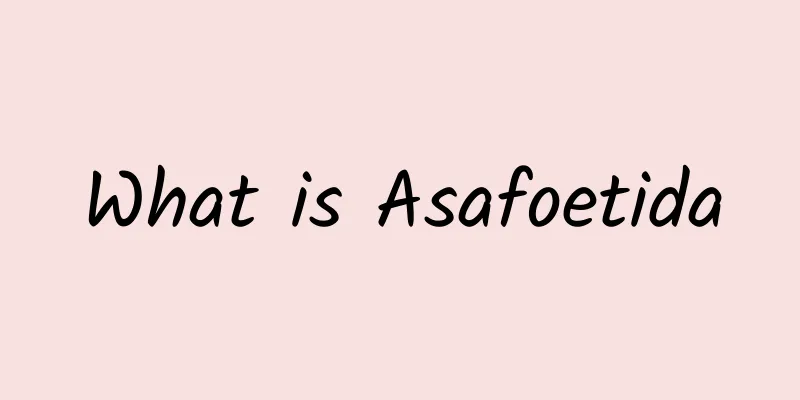What is Asafoetida

|
Traditional Chinese medicine in our country can be said to have a very long history. The fact that many Chinese herbal medicines have the ability to treat difficult and complicated diseases can no longer be explained by science. We may rarely hear about the drug asafoetida in our daily lives because this type of medicine is quite unique. In my country, it generally only appears in Xinjiang, and the number of results is relatively small. So it's normal to sound unfamiliar. In addition to identifying the appearance of the medicinal herb asafoetida, we can also smell it. Because asafoetida has a unique smell of onion and garlic, it smells a bit pungent. Therefore, Chinese medicine practitioners can collect this type of medicine by smell. Let us take a detailed look at what asafoetida is through this article. Asafoetida, also known as stinking asafoetida and fine-leaf asafoetida, is a plant of the Apiaceae family and the genus Ferula. It is a unique medicinal material in Xinjiang. Asafoetida is a perennial once-fruiting herb. There are two types of Asafoetida: Xinjiang Ferula and Round-stem Ferula. It belongs to the Apiaceae family and is a perennial herb. Xinjiang Ferula is 50-100 cm tall, with white hairs all over the plant, hypertrophic roots that are cylindrical or spindle-shaped, sometimes branched, with purple-black epidermis, a foul odor, and small yellow flowers. Compared with it, the round-stem asafoetida is twice as tall and has an upright stem. It only grows in Xinjiang in our country. Asafoetida has a pungent and warm taste and is universally recognized for its miraculous effect in attracting fish. Uighur doctors also use it to repel parasites, treat vitiligo and other traditional methods. Distributed in Central Asia, Iran and Afghanistan. [Chemical composition] Asafoetida contains volatile oil, resin and gum, etc. Good quality (granular product) can produce volatile oil 10-17%, resin 40-64%, gum about 25%, and ash about 1.5-10%. The inorganic impurities contained in block products can reach more than 60%. The volatile oil contains pinene and a variety of disulfide compounds, of which sec-butyl propenyl disulfide accounts for about 45%, which is the reason for the special garlic smell of this product. The resin contains ferulic acid and its esters, as well as farnesyl alcohol A, B, C, etc. 【Functions and indications】Curing symptoms and eliminating accumulation; killing parasites; stopping malaria. Tumors and masses; worm accumulation; food accumulation; chest and abdominal distension; cold pain; malaria; dysentery The rubber resin obtained from the root or rhizome of Ferula asafoetida is called Ferula asafoetida. It has a peculiar odor and tastes bitter and pungent. It can be absorbed from the gastrointestinal tract and has no significant toxicity even in large quantities (12 grams). It can be used as a carminative (use 4% 15-30 ml enema and take laxatives at the same time), but it should not be used within 3 days after intestinal surgery. Its volatile oil is excreted from the lungs, so it can be used as a stimulant expectorant in patients with bronchitis, whooping cough or asthma. Asafoetida decoction has an inhibitory effect on human tuberculosis in vitro, and combined with sulfur, betel nut and cinnamon Through this article, which gives a detailed introduction to asafoetida, we can understand that this Chinese herbal medicine can effectively treat some difficult and complicated diseases and is widely used as a medicine in traditional Chinese medicine. Generally, local residents in Xinjiang use it to repel insects, which is closely related to the characteristics of asafoetida. If you need it on a daily basis, it is best to take this type of medicine under the guidance of a doctor. |
Recommend
Beijing thunderstorm 8-level gale and hail is coming! Please take precautions
Beijing Meteorological Observatory issued a blue ...
China Payment and Clearing Association: WeChat Pay will be more popular than Alipay in 2022, and 80% of mobile payment users earn less than 10,000 yuan per month
In order to fully and deeply understand the curre...
The efficacy and function of Zanthoxylum bungeanum
Zanthoxylum bungeanum is a very common and freque...
Method of soaking red dates, wolfberry and ganoderma in wine
Today's society is becoming more and more dev...
Half of "Flowers" is in Huangpu! Start a Citywalk in Wong Kar-wai's style
Recently, "Fanhua" has led to a variety...
What are the medicinal materials for soaking wine to strengthen yang
Nowadays, many friends love to keep in good healt...
The efficacy and function of the iron begonia flower
As a very common Chinese medicinal material in da...
The efficacy and function of golden scissors
When it comes to golden scissors, we are all fami...
How much Chinese medicine is suitable to drink?
Although Western medicine technology is becoming ...
How to store Chinese medicine
Traditional Chinese medicine is a commonly used m...
Does Cordyceps Flower Cause Heat?
Cordyceps flower is a very common Chinese medicin...
How to fry Houttuynia cordata
You can immediately remove a few leaves from the ...
The difference between Astragalus and Radix Astragali
Do you know about Beiqi and Huangqi? They are bot...
The Strange Activities of 19th Century Scientists - Losing Cats
In the course of the development of modern physic...
The efficacy and function of Berberis nigra
For many Chinese people, traditional Chinese medi...









